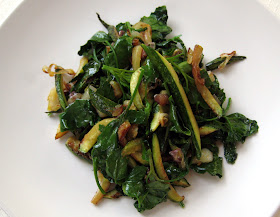On the one hand, everything I wrote here.
On the other hand, corn muffins, corn bread, cornmeal gnocchi, corn pancakes, cornmeal pizza crusts, grilled corn on the cob. Back on the first hand, corn on the cob after it's gotten stuck in your teeth when you're sitting somewhere trying to have a polite conversation with someone while developing a new technique for turning your tongue 270 degrees in order to try, and of course ultimately fail, to get it out. On the second hand, corn soup. CORN SOUP.
I have this fixation about it. Can't not order it when I see it on a swanky restaurant menu. Roll my eyes around embarrassingly in front of fellow diners while eating it. Chatter about it incessantly through the rest of the meal. "Go home!" the fellow diners say, and I reply, "Corn soup! Corn soup! Did you taste it? Wasn't it amazing?"
After a recent episode involving corn and zucchini soup at Chez Panisse, I decided it was finally time to stop mooning over it in restaurants and make it ourselves. So we did. This version serves two (or maybe three, if you were just serving little cups of it), but would be easy to double or triple. If you can find Padrón peppers (available right now at our co-op in Sacramento as well as The Spanish Table in Berkeley), they work perfectly as a garnish on the top, and you can fry a batch up to serve on the side while you're at it.
Ingredients
3 ears fresh summer corn
1 clove garlic, pressed
Olive oil
1 yellow onion, chopped
1-1/2 cups chicken broth
Salt and freshly ground black pepper
1-2 tbsps cream
3-4 Padrón peppers (optional -- you could also try a little grilled bell pepper, chopped, or just a bit of mild jalapeno, minced)
Small handful baby arugula, coarsely chopped
A few fresh cilantro berries (15 or so) or sub a little chopped fresh cilantro
Shuck the outermost leaves off the corn, leaving a couple layers of husk all the way around. Dunk the ears in a bowl of cold water and let soak for about 15 minutes. Preheat the grill to 350 degrees.
Shake the water from the ears, peel back the husk (but don't rip it off) and remove the silk. Rub each ear with some olive oil and garlic, then replace the husk and tie once around each ear with twine. Grill over medium heat for about 8 minutes, turning two or three times as it browns. Move away from the heat or to the upper rack and continue cooking another 10 minutes or so until kernels are tender. Set aside to cool, then cut the kernels from each ear.
Heat a pot over medium heat. When hot, add the olive oil, then the onion and a pinch of salt. Saute until the onion is soft and sweet-smelling. Add the corn and saute for another couple of minutes, then add enough chicken broth to cover the corn. Bring to a gentle boil, turn the heat down to medium low, and cover. Simmer 5-10 minutes, until the corn kernels taste tender and fully cooked.
Meanwhile, heat a frying pan over medium heat. When hot, add a drizzle of olive oil, then the Padrón peppers. Fry for 1-3 minutes, turning as white blisters develop on the bottom of each pepper. When all sides are blistered, turn off the heat and set the peppers aside for a couple minutes to cool. Slice crosswise into small rings.
When the soup is done, turn off the heat and puree with an immersion blender until smooth or desired consistency. If the soup is too thin, you can simmer off a little more liquid for a minute or two; if it's too thick, stir in just a bit more broth to thin it out. Next, add a dash of cumin, some freshly ground black pepper to taste, and a little more salt if needed (you probably won't need it unless your chicken broth is very low in salt). Stir in a small slosh of cream, and serve.

Garnish with cilantro berries, sliced peppers, and some chopped arugula.
Serves 2.
































